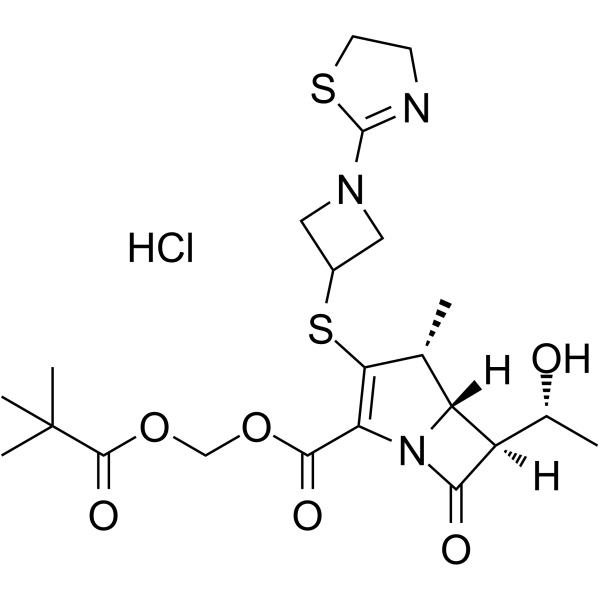Tebipenem pivoxil hydrochloride
Modify Date: 2024-04-02 19:33:42

Tebipenem pivoxil hydrochloride structure
|
Common Name | Tebipenem pivoxil hydrochloride | ||
|---|---|---|---|---|
| CAS Number | 211558-19-9 | Molecular Weight | 534.09 | |
| Density | N/A | Boiling Point | N/A | |
| Molecular Formula | C22H32ClN3O6S2 | Melting Point | N/A | |
| MSDS | N/A | Flash Point | N/A | |
Use of Tebipenem pivoxil hydrochlorideTebipenem pivoxil (L084) hydrochloride is an orally active antibiotic against a variety of pathogenic bacteria. Tebipenem pivoxil hydrochloride binds penicillin-binding protein (PBP), thereby inhibiting cell wall synthesis[1]. |
| Name | Tebipenem pivoxil hydrochloride |
|---|
| Description | Tebipenem pivoxil (L084) hydrochloride is an orally active antibiotic against a variety of pathogenic bacteria. Tebipenem pivoxil hydrochloride binds penicillin-binding protein (PBP), thereby inhibiting cell wall synthesis[1]. |
|---|---|
| Related Catalog | |
| In Vitro | Tebipenem pivoxil hydrochloride (0-128 μg/mL, 18–24 h) displays excellent antibacterial activity against a variety of pathogenic bacteria[1]. Cell Viability Assay[1] Cell Line: Gram-positive and Gram-negative bacteria Concentration: 0-128 μg/mL Incubation Time: 18–24 h Result: Showed inhibition with MIC50s below 64 μg/mL against tested Gram-positive and Gram-negative bacteria. |
| In Vivo | Tebipenem pivoxil (L084) (0-4.00 g/kg; p.o.; once) hydrochloride shows minimal lethal dosage (MLD) of 4.00 g/kg and the maximum tolerance dosage (MTD) of 3.40 g/kg in mice[1]. Tebipenem pivoxil (50 and 100 mg/kg; p.o.; once) hydrochloride significantly protects the sepsis mice challenged with various pathogenic bacteria[1]. Animal Model: KM mice weighing 18–22 g[1] Dosage: 2.89, 3.40 and 4.00 g/kg Administration: Oral administration (tablet), once Result: Within the 14-day observation period, only one mouse was dead in the maximum oral dosage (4.00 g/kg). The minimal lethal dosage (MLD) was 4.00 g/kg and the maximum tolerance dosage (MTD) in the mice was 3.40 g/kg. Showed dose-dependent liver and kidney damage. Animal Model: ICR mice, sepsis mouse models[1] Dosage: 50 and 100 mg/kg Administration: Oral administration (tablet), once Result: Significantly increased the survival number of the sepsis mice within a 168 h observation period. |
| References |
| Molecular Formula | C22H32ClN3O6S2 |
|---|---|
| Molecular Weight | 534.09 |